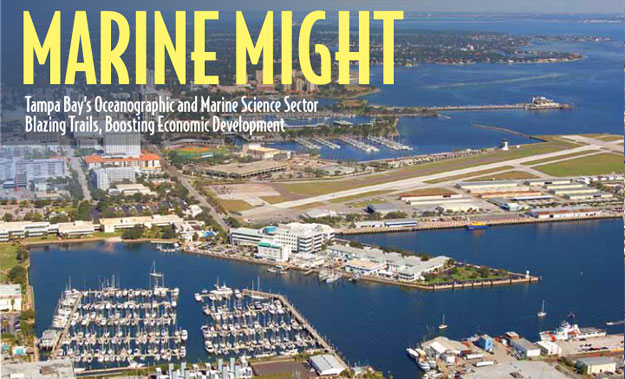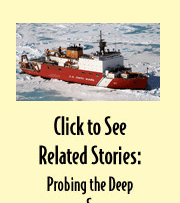 |
||||||||

From creating underwater sensors that can detect explosives on ships entering U.S. harbors to adapting marine technologies for space exploration and medical diagnostics, a cluster of businesses, agencies and organizations in St. Petersburg have propelled the Tampa Bay region to the vanguard of marine research and technology.
And its impact is growing, creating myriad opportunities for employment and new business development, according to local economic development officials who are gearing up marketing of the consortium dubbed the Ocean Team.
Anchored by the University of South Florida St. Petersburg, the city’s Bayboro Harbor Scientific District is the largest marine research complex in the Southeast. A veritable who’s who of marine science organizations, it includes the U.S. Geological Survey, NOAA’s National Marine Fisheries Service, Florida Fish & Wildlife Conservation Commission, Tampa Bay Estuary Program, Florida Institute of Oceanography, and U.S. Coast Guard, as well as nearby Eckerd College and regional partners such as Mote Marine Laboratory in Sarasota.
Attracted by the potential of research and technologies developed here, it has expanded to include such heavyweights as SRI St. Petersburg, an offshoot of renowned Silicon Valley research institute SRI International, which opened a 40,000-square-foot marine technology R&D facility here in 2007.

According to a 2010 economic analysis by the Tampa Bay Regional Planning Council, the consortium’s 1,622 employees generated $143 million in annual household earnings and created another 1,807 indirect jobs fueled by industry demand and household spending. Those jobs in turn contribute $251 million annually to Pinellas County’s gross product.
“I think the real linchpin here is the potential for research to be commercialized,” said Rick Smith, economic development coordinator for the City of St. Petersburg. “We have a concentration of marine science talent here that is unrivaled in the Southeast,” on par with Massachusetts-based Woods Hole, the largest independent oceanographic institution in the U.S., Smith said.
That potential was the magnet that lured SRI to St. Petersburg.
USF Courts Silicon Valley
SRI first visited USF in 2004. What they found was compelling: top-flight engineers at USF’s Center for Ocean Technology who were turning researchers’ ideas into devices designed to function in harsh marine environments, eager to commercialize their inventions.
Larry Langebrake, an electrical engineer by training, had been recruited to USF in 1995 by Peter Betzer, dean emeritus of the College of Marine Science and president of the St. Petersburg Downtown Partnership. Betzer appointed Langebrake director of COT in 1999. Working closely with USF marine scientists, he built the COT into a staff of about 80, designing autonomous underwater vehicles and marine sensors capable of detecting explosives and contraband attached to the hulls of ships entering harbors.
In SRI International, Betzer and Langebrake saw the potential to bring cutting-edge technologies to market that would help solve pressing real-world problems. A leader in commercializing breakthrough technologies, SRI has been responsible for developing everything from the ubiquitous PC mouse (1968) to Siri, Apple iPhone’s voice-activated virtual personal assistant (2007).
Discussions quickly evolved from using SRI as a technical advisor to having SRI establish a new marine research center in St. Petersburg. Three years later, Larry Langebrake went from director of COT to director of SRI St. Petersburg. The facility was launched with more than $30 million in public funds and 40 employees. SRI today employs more than 80 people throughout Florida with a goal of reaching 200 by 2020.
Catalyst for Economic Development
While SRI St. Petersburg clearly catapulted the marine science industry cluster to new heights, St. Pete’s national and growing international reputation as a center for marine research excellence is longstanding.
At its nucleus is the USF College of Marine Science, one of the country’s premier post graduate marine science programs.
“Scientists working at USF provide a labor force that’s attractive to high tech companies says Dave Goodwin, St. Petersburg economic development director. The College of Marine Science is a pipeline for that talent pool, adds Smith, noting the growing number of researchers, engineers and graduates now working for SRI and commercial spinoffs from the cluster.
One company, Claro Scientific, founded in 2006 as a spinoff from USF’s College of Marine Science, has developed technology that uses beams of light instead of chemical reagents to rapidly analyze blood and other fluids. The breakthrough technology, developed by former USF Professor Luis Garcio-Rubio, delivers comprehensive and highly precise analyses in minutes and stands to dramatically reduce the time and cost it takes to find and treat diseases. Clinical trials are underway. And although Claro’s chief focus is medical diagnostics, the platform technology could be adapted for applications across a wide range of markets, from biodefense to food safety and environmental monitoring.
Another early USF spinoff, Ocean Optics, is a global leader in optical sensing. Started in 1989 by Mike Morris, a graduate of the College of Marine Science, Ocean Optics develops and manufactures hand-held mass spectrometers, portable devices that measure tiny changes in light and can be used to solve problems ranging from disease detection to environmental pollution. The Dunedin-based company, which employs 218 people, was voted one of the St. Petersburg Times Top Places to Work in 2011.
After selling the company in 2004 to Halma PLC, Morris donated proceeds from the sale of a single share of the company’s stock, valued at $114,000, to the St. Petersburg Downtown Partnership, which has used the money to create a technology fund for local startups.
Serendipity Knocks

Last May, St. Petersburg took an important step toward building its international reputation as a center for marine research and conservation when Cousteau Divers opened its North American headquarters at Bayboro Harbor (see Cousteau Creates a Splash in St. Petersburg, Bay Soundings, Fall 2012). The conservation group, started by Pierre-Yves Cousteau, the youngest son of legendary ocean conservationist Jacques Cousteau, is uniting a worldwide community of divers who act as “citizen-scientists” by recording and uploading observations on the health of our oceans.
How Cousteau Divers came to St. Petersburg is a testament to the kind of targeted serendipity St. Petersburg Downtown Partnership President Peter Betzer is known for. Betzer met Cousteau in late 2010 while he was in Spain on a business trip. Recognizing what the conservation group could mean for the city in terms of business and education partnerships as well as tourism, Betzer talked to Cousteau about the city's consortium of marine science talent and resources. A visit followed, then meetings with local movers and shakers, and a scant year-and-a-half later Cousteau established its U.S. base here.
Betzer’s far-reaching sights are now set on a ‘wish list’ that includes luring SRI’s West Coast educational division here in an effort to accelerate the Tampa Bay region’s strength in STEM education – Science, Technology, Engineering and Math. In collaboration with USF St. Petersburg, the Pinellas County School District, the Helios Foundation, and Pinellas County Educational Foundation, SRI developed The SunBay Digital Mathematics Project. By using advanced technology to give students a visual as well as hands-on approach to learning, SunBay is setting the direction for the future of mathematics education for Pinellas County middle schools.

“When you see what SRI can bring, and what they’ve already done, how can you not get fired up?” Betzer says.
Betzer also hopes to boost the Ocean Team’s fleet of research vessels by convincing NOAA to bring its new 208-foot state-of-the art fisheries survey ship Pisces to St. Petersburg. It would play a critical part in expanding research to help support the West Florida Shelf, a $24-billion sport and commercial fishery, he says.
Looking Ahead
Marketing the Ocean Team is a top priority for the city’s economic development team, says Goodwin, whose group is targeting biomedical businesses among others. Two biomedical outfits have recently expressed early interest in what St. Petersburg has to offer, he adds. “When you talk about some of our major research institutions and the good things happening here, that gets attention.”
The Ocean Team was formed in 2009 to boost collaboration among disparate marine science agencies and organizations based in St. Petersburg, according to its chair, Gil McCrae, director of the Florida Fish & Wildlife Conservation Commission’s Marine Research Institute. “We recognized that we have something unique and special here that doesn’t occur but in a few places in the country,” he says. “We needed a higher visibility to push out information on the team.”
What began as a way to foster integration and communication has now evolved into more of a collective entity under the Ocean Team umbrella, explains McCrae, who credits former Mayor Rick Baker as a driver behind the consortium’s creation.
“Most of the marketing effort has been led by the City of St. Petersburg, but I think we’re just beginning and there’s a lot more opportunity to market the area as a marine science cluster,” he says.
Still, McCrae says the first priority is enhancing collaboration and partnerships among team members. “We’ve been working in similar areas for decades, but only in recent years have we started to regularly get together to talk about shared challenges and opportunities.
"There are things we may be able to take on collectively that none of us is able to tackle individually," he says. Major environmental issues like climate change, for example, or sea level rise, or simply figuring out how to better leverage resources in a down economy, he explains.
Promoting the cluster is the next priority, says McRae, who is quick to add that the Ocean Team's true impact extends well beyond jobs and economic benefits.
“When you have a large and highly specialized concentration of folks in such a small area, it has the potential to transform the community. It generates a level of community involvement and interest that goes beyond environmental issues to underscore and promote the importance of science and technology education.”
For more information on St. Petersburg’s Ocean Team and links to its partners, visit www.stpete.org/bayboro/



